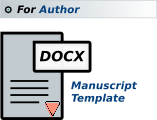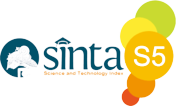Author Guidelines
General Information
Journal is published twice a year; the number of the volumes will vary. Journal will be produced after going through reviewing process from the board of editor. The article could be based on research, scientific studies, and analysis as well as the solution which are relevant with the field of electrical engineering and computer sciences. The article should never been published before. The article should have at least two authors.
Specific Information
Article should be written in A4 paper. The article should be without any page numbering and composed as follows: Abstract, Introduction, Method, Result and Discussion, Conclusion, Acknowledgements (if any), and References.
Article begins with title using font 24 pt CAPITALIZE EACH WORD format. Name of the author written under the title using font 11 pt without any academic degree. Apostrophe put behind the name of the author using superscript format. The name of the institution (name of the institution, address, phone number, fax number, and e-mail) written under the name of the author using Times New Roman 10pt. Should there are more than one author, please add the e-mail address of the corresponding author. The title of the article, name of the author and name of the institution written in the center of the field.
Abstract
Abstract should be written in English, ranging between 160-250 words. The abstract is written using Bookman Old Style bold font 9 pt in a single column format. Keywords are written below the text of the abstract and separated by comma. Keywords should be written using Times New Roman bold font 9 pt.
Content
Content of the article should be written left aligned with the left margin 1.43 cm, right margin 1.43 cm, bottom margin 1.25 cm and top margin 2.50 cm. The article should be written using MS Word using Times New Roman using 10 pt font, 1 space and in a double column format. Each article should be no more than 10 pages (including pictures and tables) justified.
Heading
Headings, or heads, are organizational devices that guide the reader through your paper. There are two types: component heads and text heads. Component heads identify the different components of your paper and are not topically subordinate to each other. Text heads organize the topics on a relational, hierarchical basis.
Pictures and Tables
Pictures and tables placed in a text with description. Pictures and tables is followed by the title of the picture placed just below the picture and the title of the table placed above the table. The title of the table and picture should be numbered. The picture should be able to be clearly printed. Pictures or diagrams/ schemes placed in the text or if the picture is too big, it can be placed in the middle of the page. The picture should not be framed.
Equation
Equation should be written center aligned and numbered in the brackets. The numbers placed at the end of the right margin of the column.
Quotation
Quotation writing of an article should be written using IEEE system. The template will number citations consecutively within brackets [1]. The sentence punctuation follows the bracket [2]. Refer simply to the reference number, as in [3]do not use Ref. [3] or reference [3] except at the beginning of a sentence: Reference [3] was the first ...
Unless there are six authors or more give all authors names; do not use et al.. Papers that have not been published, even if they have been submitted for publication, should be cited as unpublished. Papers that have been accepted for publication should be cited as in press.
Citation should be written in reference part. Every cited reference should be written completely in reference part. Unpublished reference is not suggested to be cited in article. Reference should be written according to the format of reference. This journal requires 80% of reference cited from national and international journal. Please use reference tools like Mendeley, EndNote, etc.
References
References should be arranged with numbering and the space between each item 1 space using IEEE style. The rules of the bibliography writing are as follows:
[1] S. M. Metev and V. P. Veiko, Laser Assisted Microtechnology, 2nd ed., R. M. Osgood, Jr., Ed. Berlin, Germany: Springer-Verlag, 1998.
[2] J. Breckling, Ed., The Analysis of Directional Time Series: Applications to Wind Speed and Direction, ser. Lecture Notes in Statistics. Berlin, Germany: Springer, 1989, vol. 61.
[3] S. Zhang, C. Zhu, J. K. O. Sin, and P. K. T. Mok, A novel ultrathin elevated channel low-temperature poly-Si TFT, IEEE Electron Device Lett., vol. 20, no. 11, pp. 569-571, Nov. 1999.
[4] M. Wegmuller, J. P. von der Weid, P. Oberson, and N. Gisin, High resolution fiber distributed measurements with coherent OFDR, in Proc. ECOC00, 2000, paper 11.3.4, p. 109.
[5] R. E. Sorace, V. S. Reinhardt, and S. A. Vaughn, High-speed digital-to-RF converter, U.S. Patent 5 668 842, Sept. 16, 1997.
[6] (2002) The IEEE website. [Online]. Available: http://www.ieee.org/
[7] M. Shell. (2002) IEEEtran homepage on CTAN. [Online]. Available: http://www.ctan.org/tex-archive/macros/latex/contrib/supported/IEEEtran/
[8] FLEXChip Signal Processor (MC68175/D), Motorola, 1996.
[9] PDCA12-70 data sheet, Opto Speed SA, Mezzovico, Switzerland.
[10] A. Karnik, Performance of TCP congestion control with rate feedback: TCP/ABR and rate adaptive TCP/IP, M. Eng. thesis, Indian Institute of Science, Bangalore, India, Jan. 1999.
[11] J. Padhye, V. Firoiu, and D. Towsley, A stochastic model of TCP Reno congestion avoidance and control, Univ. of Massachusetts, Amherst, MA, CMPSCI Tech. Rep. 99-02, 1999.
[12] Wireless LAN Medium Access Control (MAC) and Physical Layer (PHY) Specification, IEEE Std. 802.11, 1997.
Article Submission
Submissions should be made online via JTE submission site. The article should be written using MS Word. Reviewing process will be conducted by the Board of Editor. Any correspondence will be addressed to the main author. The author should revise the article according to the reviewer advice. The Board of Editor are entitled to reject any articles which are not relevant to subject of electrical engineering and computer sciences, not up to date, or have been published in any other scientific publication.
Tools
- Mendeley (Mendeley User Guideline)
- EndNote
- Grammarly
Article Template
Template can be found here: Article Template.



















